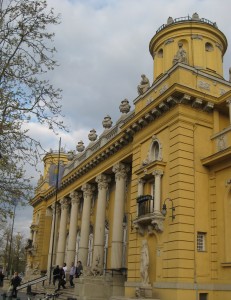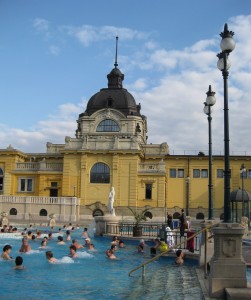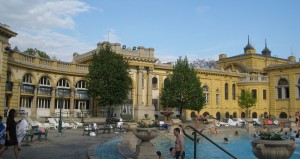It was such a relief to be on the plane that the physical discomfort of an overseas flight in coach couldn’t really touch me. I was no longer worried. D and I synchronized True Grit on our seat-back video screens, pausing at regular intervals to try to decipher Jeff Bridges’ mumblings. At the Munich Airport we made our way along endless meandering hallways, up and down countless stairs, to reach the gate for our flight to Hungary. Several hours later, we were at the Budapest Airport, where the cheerful Viking Cruise staff awaited us.
Our ship was docked in the heart of this ancient and strikingly beautiful city, immediately adjacent to the majestic Chain Bridge. The room that D and I shared looked out onto the bridge and the hilly Buda side of the city, with Buda Castle and the medieval Matthias Church nearby. A bit farther away, we could see the sleek new Elizabeth Bridge and the statue-topped Gellert Hill. My parents’ room was across the hall facing the flatter Pest side of the city.
Hungary is a land of abundant hot springs. Budapest has more than twenty thermal baths, all owned and operated by the government. According to every guidebook I consulted, the quintessential Hungarian experience is a trip to one of these baths. In the most celebrated baths, indoor and outdoor pools are grandly enclosed by elegant nineteenth-century architecture. We chose to visit the recently renovated Széchenyi Baths, which attract fewer tourists than the more upscale Gellert Baths. The friendly young woman at our ship’s concierge desk happily called a taxi when we inquired about getting to the baths. Our driver, a pleasant, talkative woman about my age, was soon whisking D and me through the city in her spotless white Mercedes. We left my parents to relax and unpack on the boat. In a quick ten minutes, we had arrived at the ornate entry building.
To foreigners, the entry procedure at the Széchenyi baths can be befuddling, to say the least. Few attendants speak English, and the notoriously difficult Hungarian language can hardly be picked up in a weekend with the help of a phrase book. Rick Steves’ e-book on Budapest offers a comprehensive guide to negotiating the baths. I had reviewed it on the plane, but we were still confused. Upon entering, one pays admission and rental for either a locker or a changing cabin. In anticipation of a trip to the baths, I had exchanged some dollars for Hungarian forints (a currency I find just as confusing as getting into the baths). Like a child, I paid by laying out the money and letting the attendant point to the required bills. I thought I had rented a changing cabin, so we wandered through the complex until we found that area, only to be told that we had paid for a locker. We roamed through additional subterranean corridors and finally located the women’s locker room. An attendant attached a wristband to my arm and showed us how to activate the lock using the attached metal disk.
Having worn our bathing suits under our clothes, it wasn’t long before we were back in the labyrinthian halls in search of the towel rental station. In an effort to be upstanding guests, we hadn’t smuggled towels with us from the boat. Next time we will not be so virtuous. The rental towels bore little relation to typical American terrycloth towels. Made of smooth heavy cotton, they were more like tablecloths. For those desiring further adventure during their baths experience, bathing suits can also be rented.
Getting out to the pools was easy, and it was wonderful to be in the open air again. Surrounded by the golden yellow Neo-Baroque buildings housing the entrance area, indoor baths, saunas and massage rooms, there are three spacious outdoor pools. The afternoon temperature was in the high 60s, and the warm water felt amazing. We spent most of our time in the semicircular “Fun Pool” which has a current circle in the center. We kept to the less populated edges.
The “Fun Pool” where we spent most of our time.
The clientele was primarily Hungarian, although we heard various other languages, including British and American English, French, German and Russian. I have never before seen such an eclectic variety of swimming attire. And no, this is not one of Budapest’s several “clothing optional” baths. Hefty grandfatherly men strutted about in tiny Speedos. Svelte young model types posed at the water’s edge in daring bikinis and spike heels. A number of older, well-covered women protected their hair with puffy shower caps. In the center lap pool, a cap is required. While some swimmers wore actual bathing caps, others sported baseball or shower caps.
The water began to feel cooler after a while, so we decided to have a look at the indoor baths. I was hoping for warmer water there. These pools were far more crowded than those outside. Along the edges, people, mostly men, stood shoulder to shoulder, staring unabashedly at any newcomers who ventured in. I was determined to test the water, so I made a quick circuit of the interior until I found a spot where the multitude was less pressing. When I dipped my foot in, the water was no warmer. We gladly returned to the unintimidating outdoor pools.
As the time approached to meet our taxi driver, the late afternoon air was taking on a serious chill. The abject deficiency of our rented towels made it difficult to emerge from the water. Our completely saturated tablecloths were icy and offered no comfort. Other towels, real, fluffy towels, folded invitingly, temptingly, seemed to mock us. I hope to never again feel such overwhelming towel envy. The comparative warmth of the taxi was especially welcome. We were invigorated by our plunge into the warmth and local color of the Széchenyi Baths. And we were glad to return to our floating haven on the Danube, which appeared even more inviting than it had at first sight.
The “Relaxation Pool” where some bathers play chess.
Helpful note on payment: Mastercard and Visa are accepted at the baths, which allows you to avoid dealing with forints. Our taxi driver preferred to be paid in Euros.



